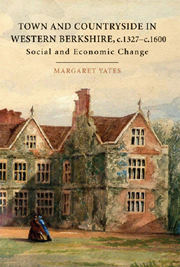Book contents
- Frontmatter
- Contents
- List of tables, figures, and maps
- Acknowledgements
- Abbreviations
- Sums of money
- 1 The end of the Middle Ages?
- 2 Landscapes, population and wealth in western Berkshire from the fourteenth to the sixteenth century
- 3 Town and country relations: Newbury and its hinterland
- 4 Estate management and profitability
- 5 Tenant society
- 6 Conclusion: the chronology of change
- Appendices
- I Documents, methodology and data relating to chapter 2
- II Comparative data for imports of woad and wine through Southampton from 1439–40 to 1491–92
- III Methodology and documentation for the case studies of chapter 4
- IV Tables containing the full data relating to chapter 5
- Bibliography
- Index
III - Methodology and documentation for the case studies of chapter 4
from Appendices
Published online by Cambridge University Press: 05 February 2013
- Frontmatter
- Contents
- List of tables, figures, and maps
- Acknowledgements
- Abbreviations
- Sums of money
- 1 The end of the Middle Ages?
- 2 Landscapes, population and wealth in western Berkshire from the fourteenth to the sixteenth century
- 3 Town and country relations: Newbury and its hinterland
- 4 Estate management and profitability
- 5 Tenant society
- 6 Conclusion: the chronology of change
- Appendices
- I Documents, methodology and data relating to chapter 2
- II Comparative data for imports of woad and wine through Southampton from 1439–40 to 1491–92
- III Methodology and documentation for the case studies of chapter 4
- IV Tables containing the full data relating to chapter 5
- Bibliography
- Index
Summary
Community case studies are the optimal method for reconstructing village life in the late medieval and early modern periods. They are, however, demanding of both time and the quality of the documentary sources. They require, particularly in the context of this study, documentary series which span the late fourteenth to sixteenth centuries in order to provide archival consistency. Records of the manor are ideal, as they cover the whole period in question and avoid the hazard that the changes observed between the medieval and early modern periods might be archivally driven and a product of the different types of documentary evidence. The manor court rolls provide information on important aspects of village life such as land and tenure, the management of the open fields, cases of violence, trespass and debt. Furthermore, they record all males over the age of 12 and are therefore an important source for calculating the size of the manor's population. The information from court rolls is augmented by that found in the ministers' accounts, particularly on the income-generating aspects of the manor. Surveys and rentals provide ‘snapshots’ of the tenurial structure of the manor at a specific moment. The quantitative use of manorial records for studies of rural society has been refined and developed over the last thirty years. The use of computer-aided analysis has revolutionised the speed with which communities can be reconstructed, it remains however a very time-consuming process, particularly if a variety of documentary sources are employed.
- Type
- Chapter
- Information
- Town and Countryside in Western Berkshire, c.1327–c.1600Social and Economic Change, pp. 264 - 267Publisher: Boydell & BrewerPrint publication year: 2007

